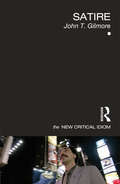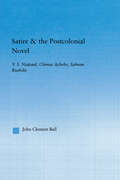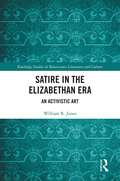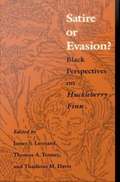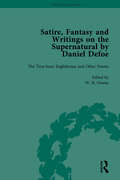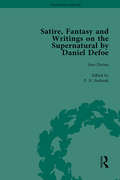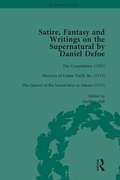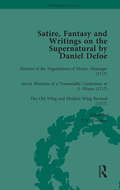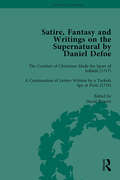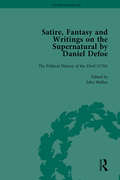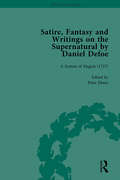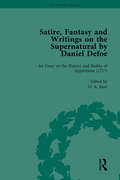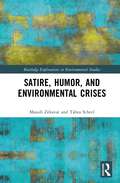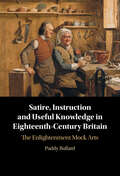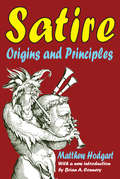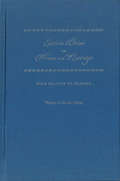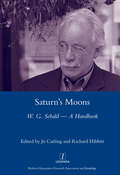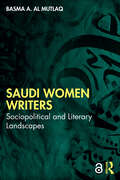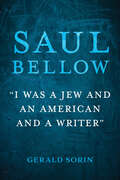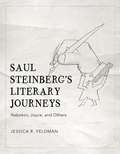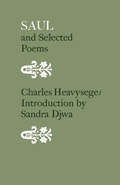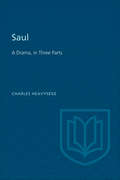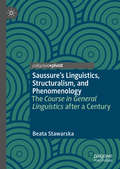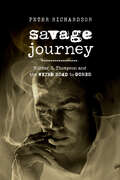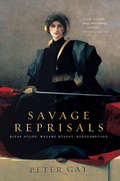- Table View
- List View
Satire (The New Critical Idiom)
by John T. GilmoreWhat is satire? How can we define it? Is it a weapon for radical change or fundamentally conservative? Is satire funny or cruel? Does it always need a target or victim? Combining thematic, theoretical and historical approaches, John T. Gilmore introduces and investigates the tradition of satire from classical models through to the present day. In a lucid and engaging style, Gilmore explores: the moral politics of satire whether satire is universal, historically or geographically limited how satire translates across genres and media the boundaries of free speech and legitimacy. Using examples from ancient Egypt to Charlie Hebdo, from European traditions of formal verse satire to imaginary voyages and alternative universes, newspaper cartoons and YouTube clips, from the Caribbean to China, this comprehensive volume should be of interest to students and scholars of literature, media and cultural studies as well as politics and philosophy.
Satire and the Postcolonial Novel: V.S. Naipaul, Chinua Achebe, Salman Rushdie (Literary Criticism and Cultural Theory)
by John Clement BallSatire plays a prominent and often controversial role in postcolonial fiction. Satire and the Postcolonial Novel offers the first study of this topic, employing the insights of postcolonial comparative theories to revisit Western formulations of "satire" and the "satiric."
Satire in the Elizabethan Era: An Activistic Art (Routledge Studies in Renaissance Literature and Culture)
by William JonesThis book argues that the satire of the late Elizabethan period goes far beyond generic rhetorical persuasion, but is instead intentionally engaged in a literary mission of transideological "perceptual translation." This reshaping of cultural orthodoxies is interpreted in this study as both authentic and "activistic" in the sense that satire represents a purpose-driven attempt to build a consensual community devoted to genuine socio-cultural change. The book includes explorations of specific ideologically stabilizing satires produced before the Bishops’ Ban of 1599, as well as the attempt to return nihilistic English satire to a stabilizing theatrical form during the tumultuous end of the reign of Elizabeth I. Dr. Jones infuses carefully chosen, modern-day examples of satire alongside those of the Elizabethan Era, making it a thoughtful, vigorous read.
Satire or Evasion?: Black Perspectives on Huckleberry Finn
by Thadious M. Davis James S. Leonard Thomas A. TenneyThough one of America's best known and loved novels, Mark Twain's Adventures of Huckleberry Finn has often been the object of fierce controversy because of its racist language and reliance on racial stereotypes. This collection of fifteen essays by prominent African American scholars and critics examines the novel's racist elements and assesses the degree to which Twain's ironies succeed or fail to turn those elements into a satirical attack on racism. Ranging from the laudatory to the openly hostile, these essays include personal impressions of Huckleberry Finn, descriptions of classroom experience with the book, evaluations of its ironic and allegorical aspects, explorations of its nineteenth-century context, and appraisal of its effects on twentieth-century African American writers. Among the issues the authors contend with are Twain's pervasive use of the word "nigger," his portrayal of the slave Jim according to the conventions of the minstrel show "darky," and the thematic chaos created by the "evasion" depicted in the novel's final chapters. Sure to provoke thought and stir debate, Satire or Evasion? provides a variety of new perspectives on one of this country's most troubling classics. Contributors. Richard K. Barksdale, Bernard W. Bell, Mary Kemp Davis, Peaches M. Henry, Betty Harris Jones, Rhett S. Jones, Julius Lester, Donnarae MacCann, Charles H. Nichols, Charles H. Nilon, Arnold Rampersad, David L. Smith, Carmen Dubryan, John H. Wallace, Kenny Jackson Williams, Fredrick Woodard
Satire, Fantasy and Writings on the Supernatural by Daniel Defoe, Part I Vol 1
by John Mullan Peter Elmer David Blewett G A Starr W R Owens P N Furbank Geoffrey SillThe publication of the 44-volume Works of Daniel Defoe continues with this collection of Defoe's satirical poetry and fantasy writings, and writings on the supernatural.
Satire, Fantasy and Writings on the Supernatural by Daniel Defoe, Part I Vol 2
by John Mullan Peter Elmer David Blewett G A Starr W R Owens P N Furbank Geoffrey SillThe publication of the 44-volume Works of Daniel Defoe continues with this collection of Defoe's satirical poetry and fantasy writings, and writings on the supernatural.
Satire, Fantasy and Writings on the Supernatural by Daniel Defoe, Part I Vol 3
by John Mullan Peter Elmer David Blewett G A Starr W R Owens P N Furbank Geoffrey SillThe publication of the 44-volume Works of Daniel Defoe continues with this collection of Defoe's satirical poetry and fantasy writings, and writings on the supernatural.
Satire, Fantasy and Writings on the Supernatural by Daniel Defoe, Part I Vol 4
by John Mullan Peter Elmer David Blewett G A Starr W R Owens P N Furbank Geoffrey SillThe publication of the 44-volume Works of Daniel Defoe continues with this collection of Defoe's satirical poetry and fantasy writings, and writings on the supernatural.
Satire, Fantasy and Writings on the Supernatural by Daniel Defoe, Part II vol 5
by W R Owens P N FurbankThe publication of the 44-volume Works of Daniel Defoe continues with this collection of Defoe's satirical poetry and fantasy writings, and writings on the supernatural.
Satire, Fantasy and Writings on the Supernatural by Daniel Defoe, Part II vol 6
by W R Owens P N FurbankThe publication of the 44-volume Works of Daniel Defoe continues with this collection of Defoe's satirical poetry and fantasy writings, and writings on the supernatural.
Satire, Fantasy and Writings on the Supernatural by Daniel Defoe, Part II vol 7
by W R Owens P N FurbankThe publication of the 44-volume Works of Daniel Defoe continues with this collection of Defoe's satirical poetry and fantasy writings, and writings on the supernatural.
Satire, Fantasy and Writings on the Supernatural by Daniel Defoe, Part II vol 8 (The\pickering Masters Ser.)
by W R Owens P N FurbankThe publication of the 44-volume Works of Daniel Defoe continues with this collection of Defoe's satirical poetry and fantasy writings, and writings on the supernatural.
Satire, Humor, and Environmental Crises (Routledge Explorations in Environmental Studies)
by Tabea Scheel Massih ZekavatSatire, Humor, and Environmental Crises explores how satire and humor can be employed to address and mitigate ecological crises at individual and collective levels. Besides scientific and technological endeavors, solutions to ecological crises must entail social and communicative reform to persuade citizens, corporations, organizations, and policymakers to adopt more sustainable lifestyles and policies. This monograph reassesses environmental behavior and messaging and explores the promises of humorous and satiric communication therein. It draws upon a solid and interdisciplinary theoretical foundation to explicate the individual, social, and ecospheric determinants of behavior. Creative works of popular culture across various modes of expression, including The Simpsons, Last Week Tonight with John Oliver, and The New Yorker cartoons, are examined to illustrate the strong if underappreciated relationship between humor and the environment. This is followed by a discussion of the instruments and methodological subtleties involved in measuring the impacts of humor and satire in environmental advocacy for the purpose of conducting empirical research. More broadly, the book aspires to participate in urgent cultural and political discussions about how we can evaluate and intervene in the full diversity of environmental crises, engage a broad set of internal and external partners and stakeholders, and develop models for positive social and environmental transformations. This book will be of great interest to students and scholars interested in environmental humanities, communication science, psychology, and critical humor studies. It can further benefit environmental activists, policymakers, NGOs, and campaign organizers.
Satire, Instruction and Useful Knowledge in Eighteenth-Century Britain: The Enlightenment Mock Arts
by Paddy BullardLong before the Industrial Revolution was deplored by the Romantics or documented by the Victorians, eighteenth-century British writers were thinking deeply about the function of literature in an age of invention. They understood the significance of 'how-to' knowledge and mechanical expertise to their contemporaries. Their own framing of this knowledge, however, was invariably satirical, critical, and oblique. While others compiled encyclopaedias and manuals, they wrote 'mock arts'. This satirical sub-genre shaped (among other works) Swift's Gulliver's Travels, Sterne's Tristram Shandy, and Edgeworth's Belinda. Eighteenth-century satirists and poets submitted to a general paradox: the nature of human skilfulness obliged them to write in an indirect and unpractical way about the practical world. As a result, their explorations of mechanical expertise eschewed useable descriptions of the mechanical trades. They wrote instead a long and peculiar line of books that took apart the very idea of an instructional literature: the Enlightenment Mock Arts.
Satire: Origins and Principles
by Matthew HodgartSatire, according to Jonathan Swift, is a mirror where beholders generally discover everybody's face but their own. and over twenty-four centuries the mirror of satirical literature has taken on many shapes. Yet certain techniques recur continually, certain themes are timeless, and some targets are perennial. Politics (the mismanagement of men by other men) has always been a target of satire, as has the war between sexes.The universality of satire as a mode and creative impulse is demonstrated by the cross-cultural development of lampoon and travesty. Its deep roots and variety are shown by the persistence of allegory, fable, aphorism, and other literary subgenres. Hodgart analyzes satire at some of its most exuberant moments in Western literature, from Aristophanes to Brecht. His analysis is supplemented by a selection and discussion of prints and cartoons.Satire continues to help us make sense of the conventions that seem to have been almost genetically transmitted from their satiric ancestors to our digital contemporaries. This is especially evident in Hodgart's repeated references to satire's predilection for the ephemeral, for camouflaging itself among the everyday, for speaking to the moment, and thus for integrating itself as deeply as possible into society. Brian Connery's new introduction places Hodgart's analysis in its proper place in the development of twentieth-century criticism.
Satiric Advice on Women and Marriage: From Plautus to Chaucer
by Warren S. SmithScholars of classics and religion, mostly British or American, sample satiric attitudes about women and marriage written in Latin from about 200 BC through Walter Map in the 12th century, with two closing chapters on Chaucer writing in Middle English during the 14th. Among their topics are Roman education and Greek rhetorical thought on marriage, advice on sex by the self-defeating satirists, Jerome and the asceticization of satire, change and continuity in pagan thought and Christian invective on women and marriage from Antiquity to the Middle Ages, and antifeminism in the High Middle Ages. Annotation ©2004 Book News, Inc. , Portland, OR (booknews. com)
Saturn's Moons: A W.G Sebald Handbook
by Jo CatlingThe German novelist, poet and critic W. G. Sebald (1944-2001) has in recent years attracted a phenomenal international following for his evocative prose works such as Die Ausgewanderten (The Emigrants), Die Ringe des Saturn (The Rings of Saturn) and Austerlitz, spellbinding elegiac narratives which, through their deliberate blurring of genre boundaries and provocative use of photography, explore questions of Heimat and exile, memory and loss, history and natural history, art and nature. Saturn's Moons: a W. G. Sebald Handbook brings together in one volume a wealth of new critical and visual material on Sebald's life and works, covering the many facets and phases of his literary and academic careers -- as teacher, as scholar and critic, as colleague and as collaborator on translation. Lavishly illustrated, the Handbook also contains a number of rediscovered short pieces by W. G. Sebald, hitherto unpublished interviews, a catalogue of his library, and selected poems and tributes, as well as extensive primary and secondary bibliographies, details of audiovisual material and interviews, and a chronology of life and works. Drawing on a range of original sources from Sebald's Nachlass - the most important part of which is now held in the Deutsches Literaturarchiv Marbach - Saturn's Moons6g will be an invaluable sourcebook for future Sebald studies in English and German alike, complementing and augmenting recent critical works on subjects such as history, memory, modernity, reader response and the visual. The contributors include Mark Anderson, Anthea Bell, Ulrich von Buelow, Jo Catling, Michael Hulse, Florian Radvan, Uwe Schuette, Clive Scott, Richard Sheppard, Gordon Turner, Stephen Watts and Luke Williams. Jo Catling teaches in the School of Literature at the University of East Anglia and Richard Hibbitt in the Department of French at the University of Leeds.
Saudi Women Writers: Sociopolitical and Literary Landscapes
by Basma A. Al MutlaqSaudi Women Writers: Sociopolitical and Literary Landscapes details the achievements of Saudi women fiction writers from the 1960s up to the present day, many of whose works have yet to be published in English translation.This book explores how various Saudi women writers’ works reflect deep social, religious and political changes over several key phases: the secularism of the 1960s and 1970s; the 1980s religious revival, or saḥwa; the post-saḥwa period; and the era of globalization. Engaging with intersectional feminism, that studies women’s texts as a multifaceted space of identity, power and agency, with the capacity to critique, and possibly dismantle, traditional hierarchies, especially amidst evolving social, religious and political landscapes. By examining the works of Samira Khashugji, Qmasha al-Olayyan, Omima al-Khamis, Zaineb Hefny, Badriya al-Beshir, Raja al-Sanea, Saba al-Herz and Warda Abdul Malik, this book charts a fresh course in literary criticism, moving beyond restrictive and monolithic perspectives.Saudi Women Writers: Sociopolitical and Literary Landscapes is an important and unique text which will be of use to both students and scholars of Gender Studies, Literature, Middle Eastern Studies, and Politics.The Open Access version of this book, available at http://www.taylorfrancis.com, has been made available under a Creative Commons Attribution-Non Commercial-No Derivatives (CC BY-NC-ND) 4.0 license.
Saul Bellow: "I Was a Jew and an American and a Writer" (The Modern Jewish Experience)
by Gerald SorinSaul Bellow: "I Was a Jew and an American and a Writer" offers a fresh and original perspective on the life and works of Saul Bellow, the Nobel Prize winner in Literature in 1976. Author Gerald Sorin emphasizes Bellow's Jewish identity as fundamental to his being and the content and meaning of his fiction. Bellow's work from the 1940s to 2000, when he wrote his last novel at the age of 84, centers on the command in Deuteronomy to "Choose life" as distinct from nihilistic withdrawal and the defense of meaninglessness.Although Bellow disdained the label of "American Jewish Writer," Sorin conjectures that he was an outstanding representative of the classification. Bellow and the characters in his fiction not only choose life but also explore what it means to live a good life, however difficult that may be to define, and regardless of how much harder it is to achieve. For Sorin, Bellow realized that at least two obstacles stood in the way: the imperfection of the world and the frailty of the human pursuer.Saul Bellow: "I Was a Jew and an American and a Writer" provides a new and insightful narrative of the life and works of Saul Bellow. By using Bellow's deeply internalized Jewishness and his remarkable imagination and creativity as a lens, Sorin examines how he captured the shifting atmosphere of postwar American culture.
Saul Steinberg's Literary Journeys: Nabokov, Joyce, and Others
by Jessica R. FeldmanSaul Steinberg’s inimitable drawings, paintings, and assemblages enriched the New Yorker, gallery and museum shows, and his own books for more than half a century. Although the literary qualities of Steinberg’s work have often been noted in passing, critics and art historians have yet to fathom the specific ways in which Steinberg meant drawing not merely to resemble writing but to be itself a type of literary writing. Jessica R. Feldman's Saul Steinberg’s Literary Journeys, the first book-length critical study of Steinberg’s art and its relation to literature, explores his complex literary roots, particularly his affinities with modernist aesthetics and iconography. The Steinberg who emerges is an artist of far greater depth than has been previously recognized. Feldman begins her study with a consideration of Steinberg as a reader and writer, including a survey of his personal library. She explores the practice of modernist parody as the strongest affinity between Steinberg and the two authors he repeatedly claimed as his "teachers"—Vladimir Nabokov and James Joyce. Studying Steinberg’s art in tandem with readings of selected works by Nabokov and Joyce, Feldman explores fascinating bonds between Steinberg and these writers, from their tastes for parody and popular culture to their status as mythmakers, émigrés, and perpetual wanderers. Further, Feldman relates Steinberg’s uniquely literary art to a host of other authors, including Rimbaud, Baudelaire, Flaubert, Gogol, Tolstoy, and Defoe. Generously illustrated with the artist’s work and drawing on invaluable archival material from the Saul Steinberg Foundation, this innovative fusion of literary history and art history allows us to see anew Steinberg’s art.
Saul and Selected Poems: A Poem in Three Cantos
by Sandra Djwa Douglas Lochhead Charles HeavysegeSaul and Selected Poems is an original and useful introduction to the work and poetic personality of Charles Heavysege (1816-76), an important but currently neglected nineteenth-century Canadian writer. Heavysege was handicapped by a limited education and a lack of public support, yet nonetheless established himself in Great Britain and America as the 'leading intellect of [the] Dominion' in a period when native literature was scantily regarded. His struggle to express himself and to find an audience for his work mirrors the dilemma of the émigré writer of his time. Heavysege's work is related in this volume to the early nineteenth-century English revival of poetic drama, and seen in the context of the Canadian cultural milieu of the 1860s. Saul is a powerful presentation of the tormented soul caught in a world of order and universal degree. Its main interest is to be found in the psychological frankness - Saul's recognition of his demon resonates with the deeper implication of the recognition of the döppelgänger - and in passages of sinewy verse written with a directness that anticipates E.J. Pratt. The text of Saul and 'Jezebel,' selections from Jephthah's Daughter, an original commentary on the major poems, a bibliography, and a review of Heavysege criticism are all included in this volume. (Literature of Canada 19)
Saul: A Drama, in Three Parts (Second Edition)
by Douglas Lochhead Charles HeavysegeCharles Heavysege's chief and best-known work, the long-verse drama and tragedy Saul, was published in Montreal in 1857. Coventry Patmore, reviewing Saul in the North British Review, ranked it as the greatest English poem published outside Great Britain. Hawthorne, Emerson, and Longfellow were all enthusiastic in their praise, and the play went into three editions. Saul is a drama of 135 scenes containing the remarkable character of the fallen angel Malzah, who has been compared by critics to Shakespeare’s Caliban. Itis a powerful presentation of the tormented soul caught in a world of order and universal degree. Its main interest is to be found in the psychological frankness - Saul's recognition of his demon resonates with the deeper implication of the recognition of the döppelgänger - and in passages of sinewy verse written with a directness that anticipates E.J. Pratt.
Saussure’s Linguistics, Structuralism, and Phenomenology: The Course in General Linguistics after a Century
by Beata StawarskaThis is the first English-language guidebook geared at an interdisciplinary audience that reflects relevant scholarly developments related to the legacy and legitimacy of Ferdinand de Saussure's Course in General Linguistics (1916) today. It critically assesses the relation between materials from the Course and from the linguist’s Nachlass (works unpublished or even unknown at Saussure’s death, some of them recently discovered). This book pays close attention to the set of oppositional pairings: the signifier and the signified, la langue (language system) and la parole (speech), and synchrony and diachrony, that became the hallmark of structuralism across the humanities. Sometimes referred to as the “Saussurean doctrine,” this hierarchical conceptual apparatus becomes revised in favor of a horizontal set of relations, which co-involves speaking subjects and linguistic structures. This book documents the continued relevance of Saussure’s linguistics in the 21st Century, and it sheds light on its legacy within structuralism and phenomenology. The reader can consult the book on its own, or in tandem with the 1916 Course.
Savage Journey: Hunter S. Thompson and the Weird Road to Gonzo
by Peter RichardsonA superbly crafted study of Hunter S. Thompson’s literary formation, achievement, and continuing relevance. Savage Journey is a "supremely crafted" study of Hunter S. Thompson's literary formation and achievement. Focusing on Thompson's influences, development, and unique model of authorship, Savage Journey argues that his literary formation was largely a San Francisco story. During the 1960s, Thompson rode with the Hell's Angels, explored the San Francisco counterculture, and met talented editors who shared his dissatisfaction with mainstream journalism. Author Peter Richardson traces Thompson's transition during this time from New Journalist to cofounder of Gonzo journalism. He also endorses Thompson's later claim that he was one of the best writers using the English language as both a musical instrument and a political weapon. Although Thompson's political commentary was often hyperbolic, Richardson shows that much of it was also prophetic. Fifty years after the publication of Fear and Loathing in Las Vegas, and more than a decade after his death, Thompson's celebrity continues to obscure his literary achievement. This book refocuses our understanding of that achievement by mapping Thompson's influences, probing the development of his signature style, and tracing the reception of his major works. It concludes that Thompson was not only a gifted journalist, satirist, and media critic, but also the most distinctive American voice in the second half of the twentieth century.
Savage Reprisals: Bleak House, Madame Bovary, Buddenbrooks
by Peter GayA revelatory work that examines the intricate relationship between history and literature, truth and fiction--with some surprising conclusions. Focusing on three literary masterpieces--Charles Dickens's Bleak House (1853), Gustave Flaubert's Madame Bovary (1857), and Thomas Mann's Buddenbrooks (1901)--Peter Gay, a leading cultural historian, demonstrates that there is more than one way to read a novel. Typically, readers believe that fiction, especially the Realist novels that dominated Western culture for most of the nineteenth century and beyond, is based on historical truth and that great novels possess a documentary value. That trust, Gay brilliantly shows, is misplaced; novels take their own path to reality. Using Dickens, Flaubert, and Mann as his examples, Gay explores their world, their craftsmanship, and their minds. In the process, he discovers that all three share one overriding quality: a resentment and rage against the society that sustains the novel itself. Using their stylish writing as a form of revenge, they deal out savage reprisals, which have become part of our Western literary canon. A New York Times Notable Book and a Best Book of 2002.
